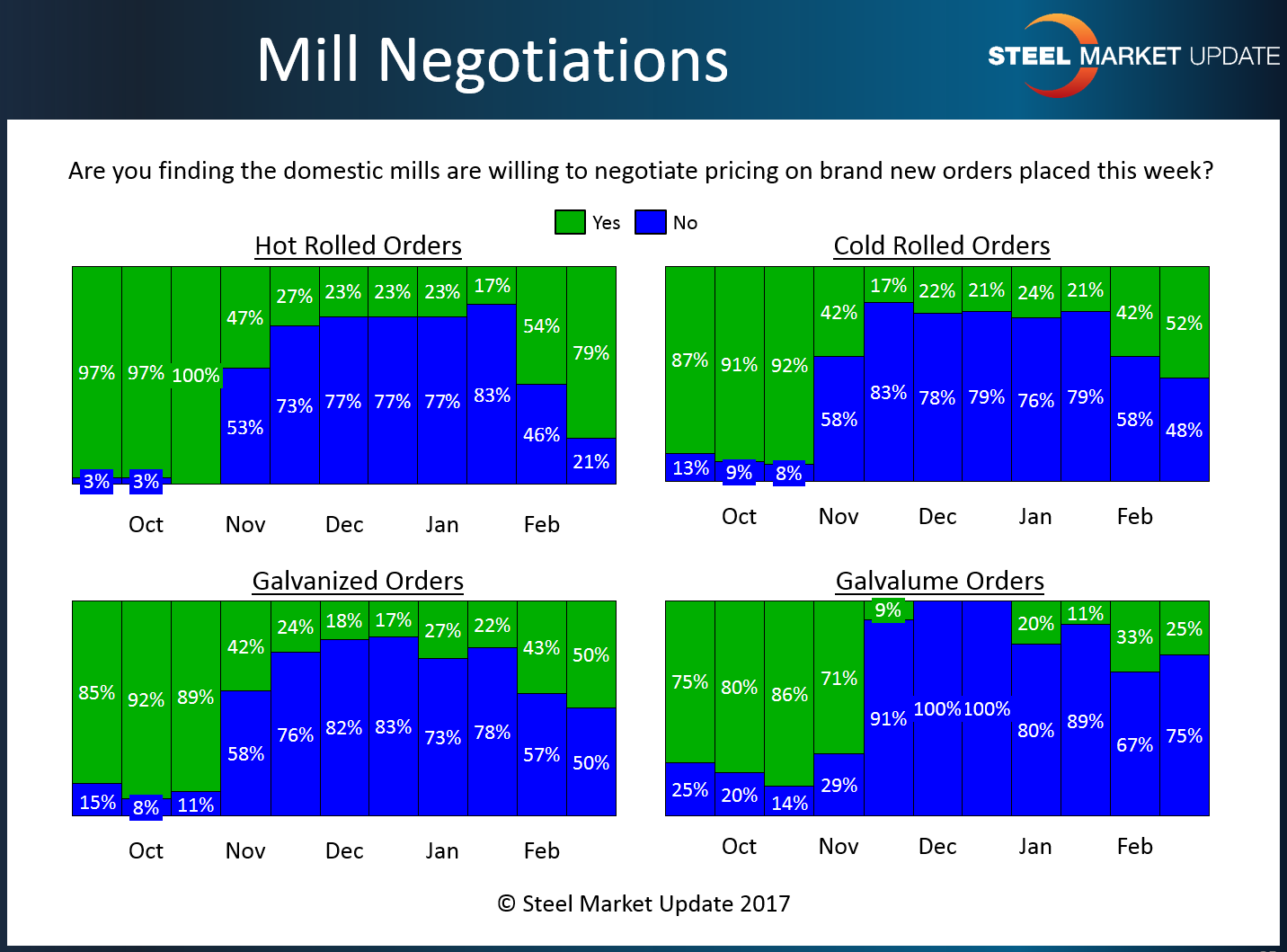SMU Data and Models

Steel Mill Price Negotiations on Flat Rolled Increasing
Written by John Packard
February 19, 2017
The respondents to our latest SMU Flat Rolled Steel Market Trends Analysis are reporting steel mills as actively negotiating prices on all flat rolled with the possible exception of Galvalume.
Seventy-nine percent of the respondents reported steel mills as willing to negotiate hot rolled spot pricing. We need to go back to our mid-October 2016 analysis in order to find a percentage exceeding 50 percent.
Fifty-two percent of our respondents reported steel mills willing to negotiate cold rolled prices. As with hot rolled above, you need to go back to mid-October 2016 to find the mills as willing to talk about cold rolled steel prices.
Fifty percent of those responding to our questionnaire reported galvanized spot prices as negotiable. In mid-October 2016 the percentage was 89 percent.
Galvalume has fared better than HR, CR an GI products as only twenty-five percent of our respondents reported AZ prices as being negotiable. In early November 2016, that percentage was 71 percent.
SMU Note: In late October, the domestic steel mills began announcing price increases which resulted in prices going up by a minimum of $160 per ton before slipping back recently.
A side note: The data for both lead times and negotiations comes from only service center and manufacturer respondents. We do not include commentary from the steel mills, trading companies, or toll processors in this particular group of questions.
To see an interactive history of our Steel Mill Negotiations data, visit our website here.

John Packard
Read more from John PackardLatest in SMU Data and Models

SMU Scrap Survey: Sentiment Indices rise
Both current and future scrap sentiment jumped this month, though survey participants reported responses before key trade news was announced.

SMU Survey: Sentiment splits, buyers have better view of future than the present
SMU’s Steel Buyers’ Sentiment Indices moved in opposite directions this week. After rebounding from a near five-year low in late June, Current Sentiment slipped again. At the same time, Future Sentiment climbed to a four-month high. Both indices continue to show optimism among buyers about their company’s chances for success, but suggest there is less confidence in that optimism than earlier in the year.

SMU scrap market survey results now available
SMU’s ferrous scrap market survey results are now available on our website to all premium members. After logging in at steelmarketupdate.com, visit the pricing and analysis tab and look under the “survey results” section for “ferrous scrap survey” results. Past scrap survey results are also available under that selection. If you need help accessing the survey results […]

SMU flat-rolled market survey results now available
SMU’s latest steel buyers market survey results are now available on our website to all premium members. After logging in at steelmarketupdate.com, visit the pricing and analysis tab and look under the “survey results” section for “latest survey results.” Past survey results are also available under that selection. If you need help accessing the survey results, or if […]

SMU Survey: Sheet lead times stabilize, plate contracts
Mill lead times for sheet products were steady to slightly longer this week compared to our late June market check, while plate lead times contracted, according to steel buyers responding to this week’s market survey.

